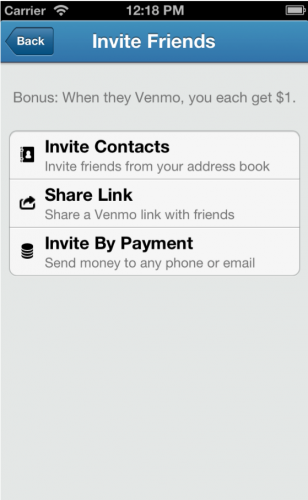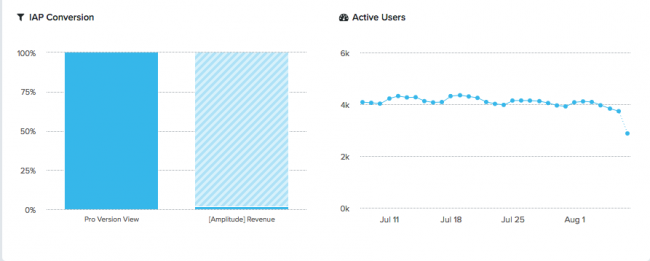Getting Started with Mobile Analytics
Check out some real-world success stories of using mobile analytics, the best providers to use, and a simple three step approach to getting started. By Kishin Manglani.
Sign up/Sign in
With a free Kodeco account you can download source code, track your progress, bookmark, personalise your learner profile and more!
Create accountAlready a member of Kodeco? Sign in
Sign up/Sign in
With a free Kodeco account you can download source code, track your progress, bookmark, personalise your learner profile and more!
Create accountAlready a member of Kodeco? Sign in
Contents
Getting Started with Mobile Analytics
20 mins
- Why Mobile Analytics?
- Analytics Example 1: Venmo
- Analytics Example 2: Steps
- Conclusions from Examples
- Which Analytics to Collect?
- Basic Data
- Custom Events
- Custom Events Example 1: Venmo
- Custom Events Example 2: Calm
- Top 3 Mobile Analytic Providers
- 1. Firebase
- 2. Amplitude
- 3. Mixpanel
- Honorable Mention: AWS Mobile Analytics
- What About iTunes Connect?
- Where to Go From Here?
Custom Events Example 1: Venmo
At Venmo, referral invites was one of the key drivers of growth. In our original app design, we had a screen that let users select whether they wanted to send email or SMS invites prior to showing the user a list of contacts to invite.

After adding custom events for each part of the invite flow to the app, we quickly realized that most users skipped invitations altogether because of this intermediary screen. So we tried removing the screen and taking the users straight to a list of contacts, and saw the following results (green being before, orange being after):
You can clearly see the bump in invites!

You can clearly see the bump in invites!
With the help of custom events, we ultimately increased invites significantly by deleting code!
Adding analytics around key areas that you want to optimize in your app is definitely the correct approach, as opposed to adding analytics everywhere and trying to figure things out as you go along.
Custom Events Example 2: Calm
Another great analytics success story is from the team behind the meditation app Calm, who had a goal of improving user retention.
In other words, they wanted to increase active users, which is the number of distinct users your app has within a specific timeframe.
One feature in Calm an opt-in daily notification to remind users to perform their meditation session. The team wondered if users who opted-in to the daily notification enabled were more likely to return to the app.
So the team added a custom event around the daily reminder feature and created a cohort — a specific subset of users based on some criteria — for users who enabled the daily reminder.
They found that users who had enabled the reminder were at least three times more likely to return to the app!
The blue line shows users with the reminder enabled and the red users without the reminder. These are not exact numbers.

The blue line shows users with the reminder enabled and the red users without the reminder. These are not exact numbers.
However, the reminder feature was buried deep in the app, so only a small fraction of users actually used this feature:
Buried features seldom get used.

Buried features seldom get used.
To fix this, the team then added features including a prompt to encourage users to set the reminder, and displayed the prompt after a user had completed their first meditation session. 40% of users who saw the prompt enabled daily reminders.
The prompt that increased retention by 3x.

The prompt that increased retention by 3x.
This led to massive growth in active users – another example of custom events for the win.
Top 3 Mobile Analytic Providers
Now that you’ve hopefully been convinced of the benefits of mobile analytics, let’s discuss which analytic provider to use.
Note that there are many mobile analytics providers that make it easy to collect, aggregate, and analyze data. I would highly recommend using one of these platforms instead of building your own, as in-house analytics tracking can quickly become difficult to manage. In fact, some companies try to do it in-house and later realize it ends up being more cost-effective to go with a third-party solution.
I’ve narrowed my choices down to three options based on the following four factors:
- Features: Features are most important because you want to make sure you’re not losing out on valuable insights.
- Dashboard UI: An easy to use, intuitive dashboard UI not only makes it easy to explore your data, but fun as well. It’s easy to forget about analytics when you are caught up with other aspects of your app.
- Price: The price of some analytics packages can quickly soar with increased usage, which is why it’s important to be mindful of what you track.
- Longevity: Finding an analytics provider with some amount of longevity will pay off in the long run. Choosing an analytics provider that has a big team, with lots of funding and established customers can help protect you against your analytics provider disappearing tomorrow — and losing all your analytic data.
Below are three options I recommend most often — plus one honorable mention!
1. Firebase
Demographics and Interests data from Firebase

Demographics and Interests data from Firebase
The recent re-launch of Firebase makes it seem like Google is trying to merge Google Analytics for Mobile and Firebase. Google has ported most of the core features of GA to Firebase in a more mobile-focused suite.
For example, in-app-purchases are prominent in the default Firebase dashboard. Demographics data is presented in a consolidated, easier to understand manner.
Firebase also has a suite of other features, from a realtime database, to user authentication, to push notifications. Firebase is a great choice, especially if you decide to use the other features it has to offer.
Firebase offers a lot of different analytics out of the box. It gives you high-level demographics data, like gender, location, and even different interest categories for users. It can also tell you the percentage of users on various operating systems or devices. It’s also easy to create segments, track retention, build funnels, and much more.
Overall, Firebase Analytics has many features and is still fairly new. I’m excited to see how it develops further! Firebase Analytics is free, which is a huge plus.
Pros
- Free
- Demographics and Interests Data
- Lots of useful features
Cons
- Can feel feature-bloated
- Fewer enterprise level-features
2. Amplitude

Amplitude is a great mobile analytics package that provides many high-level analytics, but doesn’t have any gender or interests demographics data. Amplitude’s analytics are also real-time, which I like.
Immediately after releasing a new app version in the App Store, it’s possible to see how new features are performing or how various tweaks have improved the app. It’s also great to get a pulse on how many users are using the app on any given day.
Amplitude’s free tier offers 10 million monthly events, which is quite generous. But pricing goes up quickly to $2,000/month, which is definitely a major downside. However, the analytics feature set and generous free package outweigh that.
Pros
- Intuitive user interface
- Robust; analytics is the focus
- Generous free tier
Cons
- Paid tiers can be pricey
- Fewer features beyond mobile analytics